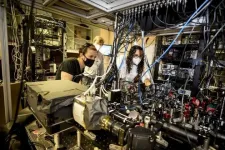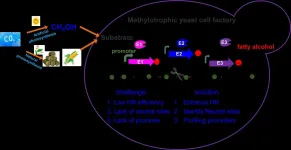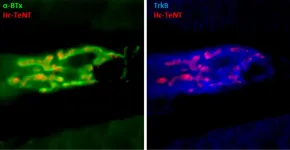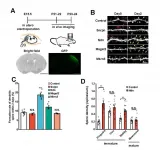(Press-News.org) A team of physicists from the Harvard-MIT Center for Ultracold Atoms and other universities has developed a special type of quantum computer known as a programmable quantum simulator capable of operating with 256 quantum bits, or "qubits."
The system marks a major step toward building large-scale quantum machines that could be used to shed light on a host of complex quantum processes and eventually help bring about real-world breakthroughs in material science, communication technologies, finance, and many other fields, overcoming research hurdles that are beyond the capabilities of even the fastest supercomputers today. Qubits are the fundamental building blocks on which quantum computers run and the source of their massive processing power.
"This moves the field into a new domain where no one has ever been to thus far," said Mikhail Lukin, the George Vasmer Leverett Professor of Physics, co-director of the Harvard Quantum Initiative, and one of the senior authors of the study published today in the journal Nature. "We are entering a completely new part of the quantum world."
According to Sepehr Ebadi, a physics student in the Graduate School of Arts and Sciences and the study's lead author, it is the combination of system's unprecedented size and programmability that puts it at the cutting edge of the race for a quantum computer, which harnesses the mysterious properties of matter at extremely small scales to greatly advance processing power. Under the right circumstances, the increase in qubits means the system can store and process exponentially more information than the classical bits on which standard computers run.
"The number of quantum states that are possible with only 256 qubits exceeds the number of atoms in the solar system," Ebadi said, explaining the system's vast size.
Already, the simulator has allowed researchers to observe several exotic quantum states of matter that had never before been realized experimentally, and to perform a quantum phase transition study so precise that it serves as the textbook example of how magnetism works at the quantum level.
These experiments provide powerful insights on the quantum physics underlying material properties and can help show scientists how to design new materials with exotic properties.
The project uses a significantly upgraded version of a platform the researchers developed in 2017, which was capable of reaching a size of 51 qubits. That older system allowed the researchers to capture ultra-cold rubidium atoms and arrange them in a specific order using a one-dimensional array of individually focused laser beams called optical tweezers.
This new system allows the atoms to be assembled in two-dimensional arrays of optical tweezers. This increases the achievable system size from 51 to 256 qubits. Using the tweezers, researchers can arrange the atoms in defect-free patterns and create programmable shapes like square, honeycomb, or triangular lattices to engineer different interactions between the qubits.
"The workhorse of this new platform is a device called the spatial light modulator, which is used to shape an optical wavefront to produce hundreds of individually focused optical tweezer beams," said Ebadi. "These devices are essentially the same as what is used inside a computer projector to display images on a screen, but we have adapted them to be a critical component of our quantum simulator."
The initial loading of the atoms into the optical tweezers is random, and the researchers must move the atoms around to arrange them into their target geometries. The researchers use a second set of moving optical tweezers to drag the atoms to their desired locations, eliminating the initial randomness. Lasers give the researchers complete control over the positioning of the atomic qubits and their coherent quantum manipulation.
Other senior authors of the study include Harvard Professors Subir Sachdev and Markus Greiner, who worked on the project along with Massachusetts Institute of Technology Professor Vladan Vuleti?, and scientists from Stanford, the University of California Berkeley, the University of Innsbruck in Austria, the Austrian Academy of Sciences, and QuEra Computing Inc. in Boston.
"Our work is part of a really intense, high-visibility global race to build bigger and better quantum computers," said Tout Wang, a research associate in physics at Harvard and one of the paper's authors. "The overall effort [beyond our own] has top academic research institutions involved and major private-sector investment from Google, IBM, Amazon, and many others."
The researchers are currently working to improve the system by improving laser control over qubits and making the system more programmable. They are also actively exploring how the system can be used for new applications, ranging from probing exotic forms of quantum matter to solving challenging real-world problems that can be naturally encoded on the qubits.
"This work enables a vast number of new scientific directions," Ebadi said. "We are nowhere near the limits of what can be done with these systems."
INFORMATION:
How does unicellular life transition to multicellular life? The research team of Professor Lutz Becks at the Limnological Institute of the University of Konstanz has taken a major step forward in explaining this very complex process. They were able to demonstrate - in collaboration with a colleague from the Alfred Wegner Institute (AWI) - that the unicellular green algae Chlamydomonas reinhardtii, over only 500 generations, develops mutations that provide the first step towards multicellular life. This experimentally confirmed a theory on the origin of multicellular life, which says that the evolution of cell groups and the subsequent steps towards multicellularity can only take place when cell groups are both better at reproduction and more likely to survive than single cells. ...
Although the giant panda is in practice a herbivore, its masticatory system functions differently from the other herbivores. Through the processes of natural selection, the giant panda's dietary preference has strongly impacted the evolution of its teeth and jaws. Researchers from the Institute of Dentistry at the University of Turku and the Biodiversity unit of the University of Turku together with researchers from the China Conservation and Research Center for Giant Panda (CCRCGP) have been the first in the world to solve the mystery of how the giant panda's special stomatognathic system functions.
The bamboo diet of the giant panda (Ailuropoda melanoleuca) has long been a ...
Pichia pastoris (syn. Komagataella phaffii), a model methylotrophic yeast, can easily achieve high density fermentation, and thus is considered as a promising chassis cell for efficient methanol biotransformation. However, inefficient gene editing and lack of synthetic biology tools hinder its metabolic engineering toward industrial application.
Recently, a research group led by Prof. ZHOU Yongjin from the Dalian Institute of Chemical Physics (DICP) of the Chinese Academy of Sciences established an efficient genetic engineering platform in Pichia pastoris.
The study was published in Nucleic Acids Research on July 1.
The researchers developed ...
Depression has been treated traditionally with inhibitors of serotonin reuptake in the central nervous system. These drugs do not come without side effects, such as lack of immediate therapeutic action, the need for daily doses and the danger of becoming addicted to some of these drugs. That is why scientists continue to work on new therapies to treat depression.
In 2019, an international group of researchers co-led by Dr Yousef Tizabe from the Howard University College of Medicine in Washington, D.C., and Professor José Aguilera from the Department of Biochemistry and Molecular Biology and the Institut de Neurociències ...
To splice or not to splice...
In an article published in the journal RNA, Karan Bedi, a bioinformatician in Mats Ljungman's lab, Department of Radiation Oncology at the University of Michigan Medical School, investigated the efficiency of splicing across different human cell types. The results were surprising in that the splicing process appears to be quite inefficient, leaving most intronic sequences untouched as the transcripts are being synthesized. The study also reports variable patterns between the different introns within a gene and across cell lines, and it further highlights ...
Researchers at the University of Freiburg and the University of Stuttgart have developed a new process for producing movable, self-adjusting materials systems with standard 3D-printers. These systems can undergo complex shape changes, contracting and expanding under the influence of moisture in a pre-programmed manner. The scientists modeled their development based on the movement mechanisms of the climbing plant known as the air potato (Dioscorea bulbifera). With their new method, the team has produced its first prototype: a forearm brace that adapts to the wearer and which can be further developed for medical applications. ...
Recess quality, not just the amount of time spent away from the classroom, plays a major role in whether children experience the full physical, mental and social-emotional benefits of recess, a new study from Oregon State University found.
"Not all recess is created equal," said William Massey, study author and an assistant professor in OSU's College of Public Health and Human Sciences. With schools returning to full-time in-person classes this fall, he said, "Now is a good time to rethink, 'How do we create schools that are more child-friendly?' I think ensuring quality access to play time and space during the school day is a way we can do that." ...
A research group including Kobe University's Professor TAKUMI Toru (also a Senior Visiting Scientist at RIKEN Center for Biosystems Dynamics Research) and Assistant Professor TAMADA Kota, both of the Physiology Division in the Graduate School of Medicine, has revealed a causal gene (Necdin, NDN) in autism model mice that have the chromosomal abnormality (*1) called copy number variation (*2).
The researchers hope to illuminate the NDN gene's molecular mechanism in order to contribute towards the creation of new treatment strategies for developmental disorders including autism.
These research results were published in Nature Communications on July 1, 2021.
Main Points
The research ...
Although Covid-19 affects men and women differently, the large majority of current clinical studies of SARS-CoV-2 and COVID-19 makes no mention of sex/gender. Indeed, only a fraction, 4 percent, explicitly plan to address sex and gender in their analysis, concludes a new analysis of nearly 4,500 studies. 21 percent only take this variable into account when selecting participants while 5.4 % go as far as planning to have sex-matched or representative subgroups and samples. The article is published in Nature Communications.
During the corona pandemic, differences can be observed between men and women. Men are more vulnerable to a severe course of COVID-19; ...
Tokyo, Japan - Scientists from The University of Tokyo Institute of Industrial Science have designed a machine learning algorithm to predict the size of an individual cell as it grows and divides. By using an artificial neural network that does not impose the assumptions commonly employed in biology, the computer was able to make more complex and accurate forecasts than previously possible. This work may help advance the field of quantitative biology as well as improve the industrial production of medications or fermented products.
As in all of the natural sciences, biology has developed mathematical models to help fit data and make predictions about the future. However, because of the inherent complexities of living ...








